October 7 marked the 19th anniversary of the start of the U.S. war in Afghanistan. There is no doubt that the costs of this war to America and to Afghans have been enormous, and it’s time for it to wind down. It is also clear that the only way out is a negotiated peace, taking the form of two agreements: one struck between America and the Taliban (which was signed in February, and for which the Trump administration deserves credit), and another between the Taliban and the Afghan government (for which talks are currently underway in Doha). Most can agree on those basic principles.
Yet the discussion in Washington on policy options for Afghanistan — beyond the unhelpful campaign rhetoric and unexpected pronouncements from President Trump — is usually framed as a binary choice between two extremes. At one end, it’s argued that in order to guarantee any semblance of human rights or democracy in Afghanistan, we would have to stay there indefinitely, consigning another generation to fighting an unwinnable war half a world away. But, the argument adds, we actually have no responsibility to guarantee these values and principles in Afghanistan via a troop presence: Do we, after all, use troops to enforce democracy or women’s rights in any country where those are deficient or threatened? At the other end, it’s argued that we should abide by the U.S.-Taliban deal — the best that we could get, the argument goes — and withdraw all troops by May 2021 as long as counterterrorism commitments are met, as the letter of the February 29 deal dictates. Presented in this binary way, it seems obvious that it’s better to leave by May 2021, regardless of progress (or lack thereof) on the intra-Afghan deal.
But this choice is a false one. It misses the third option: that America stay in Afghanistan until an intra-Afghan peace deal is reached, and condition its full troop withdrawal on the achievement of that deal. That is not the same thing as staying forever. It likely means we would need to keep a few thousand troops in Afghanistan beyond May 2021. The intra-Afghan negotiations that began in Doha on September 12 are complicated, painstakingly slow, and should not be rushed. America is helping that process, and Pakistan is involved as well. Though U.S. Special Representative for Afghanistan Reconciliation Zalmay Khalilzad said recently that a deal between the Afghans may take months, not years, analysts argue that once the pressure of a U.S. election has passed, the process will probably take several years. It may stall, or stop and start.
For U.S. soldiers to stay until an intra-Afghan peace deal is secured would be the best hope for securing a favorable outcome for both Afghans and Americans. That could mean that several thousand U.S. soldiers remain in Afghanistan for the next three to five years after the troop withdrawal scheduled for November 2020, at which point the number of troops will fall to 4,500. We could withdraw some people beyond that number, conditional on visible and sustained progress on an intra-Afghan deal. Even at an upper bound of 4,500, our troop presence for the next few years would still be less than 5% of what it was at the peak of the war in 2010-11.
Some might argue that staying beyond May 2021 would violate the February 29 agreement between Washington and the Taliban. But both the late start of the intra-Afghan peace negotiations (which began months after they were required to begin) and the Taliban’s continuing relationship with al-Qaida already violate the deal. More substantively, Ambassador Khalilzad, Secretary of Defense Mark Esper, and others in the administration have publicly said that American troop withdrawals beyond those currently scheduled for November 2020 will be based on “conditions on the ground.” This phrase is usually understood to imply an evaluation of whether the Taliban has kept its counterterrorism commitments, and also an assessment of levels of violence on the ground between the Taliban and the Afghans (violence that has, tragically for so many, continued unabated through the spring and summer). Khalilzad often refers to phrasing in the text of the February 29 deal that establishes four parts as interrelated: the U.S. withdrawal, Taliban counterterrorism commitments, a lasting ceasefire, and a roadmap for the intra-Afghan deal. While the wording doesn’t make explicit that withdrawal hinges on a ceasefire and the intra-Afghan deal, it can be read to imply that; I’d argue that we should use any ambiguity in the deal to stay until an intra-Afghan peace deal is achieved.
Doing so is the best way to throw our support behind the Afghan government and people, shedding the farce of neutrality Washington has had to maintain. Bolstering the Afghan government helps it fight to maintain the gains made in women’s rights, human rights, and democracy — all values we hold dear and that we helped foster in Afghanistan over the last 19 years, but cannot impose ourselves. By leaving before an intra-Afghan peace deal is reached, we risk plunging Afghanistan into further conflict leading to a Taliban victory; not only would that be a disservice to Afghans who have benefited from a realization of their rights, we would do ourselves a disservice by wiping away the gains we have helped achieve. To say that we have zero responsibility to safeguard these gains is disingenuous, and will not be looked upon kindly by Afghans.
Lost in the discussions in Washington are the voices of Afghans themselves — such as that of a young victim of a recent blast in Nangarhar, whose notebook with the handwritten poem saying “what kind of people are these? Leaves you perplexed” was found after his death. America is uniquely implicated in Afghanistan’s trajectory; that involvement has come at the great cost of American money and lives over the past two decades, but also Afghan lives over 40 years. The Afghans, after all, helped America win the Cold War in the 1980s. The argument that America is leaving because its costs in Afghanistan are sunk will cause many Afghans to blame America for the country’s future problems.
Leaving now is akin to quitting the race when the finish line is in sight.
I’ve struggled with the argument that the U.S. should remain in Afghanistan for a period, because it’s often seen as endorsing a perpetuation of war. And in the aftermath of the U.S.-Taliban deal this year, American troops have seen zero casualties. But leaving now is akin to quitting the race when the finish line is in sight. Pulling out precipitously is an invitation to a cycle of violence and civil war, as my colleague Michael O’Hanlon has argued. And beyond real outcomes, we underestimate the power of the narrative in the region at our peril.
Some argue that we should concentrate our efforts on maintaining diplomatic and economic leverage over Afghanistan post-withdrawal. But we should be clear that our pre-withdrawal leverage is far greater than any post-withdrawal leverage would be, especially in the context of new reporting that suggests that the Taliban may financially need America less than we think.
Afghanistan’s neighbor Pakistan, for its part, also says that it does not want a precipitous international withdrawal from Afghanistan. Its prime minister, who has long supported a political solution to the war, recently argued that he wants to see an international presence there until an intra-Afghan peace deal is reached, no matter how long it might take.
In recent months, the Trump administration has tended to brush the Taliban’s violence under the rug, and to paint the terrorist group with a soft brush, all in the interest of getting out of America’s “endless war.” There is also a tendency to overstate Americans’ wariness with war, which is perhaps driven as much by the narrative coming from Washington as the other way around. A January 2020 poll by the Chicago Council for Global Affairs, for example, found that Americans are “evenly divided on whether the United States should have long-term bases in Afghanistan” (48% said that they should, 49% said they should not). That, the poll found, was “the highest level of support for basing in that country since 2010.”
The argument for staying in Afghanistan until an intra-Afghan peace deal is reached isn’t driven by unrealistic idealism around promoting human rights and democracy, nor support for a nation-building project, nor the desire for endless war. It derives from a recognition that undesirable outcomes down the road in Afghanistan will be considered America’s failure. We have a policy option at hand to achieve a better outcome for both America and Afghans. Those considering policy decisions in Afghanistan should ignore empty campaign rhetoric — such as that coming from our president — and choose to keep some troops on the ground until the Afghans have arrived at an agreement on the future of their country.
The Brookings Institution is committed to quality, independence, and impact.
We are supported by a diverse array of funders. In line with our values and policies, each Brookings publication represents the sole views of its author(s).

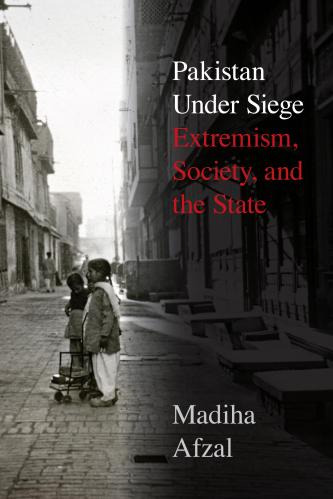
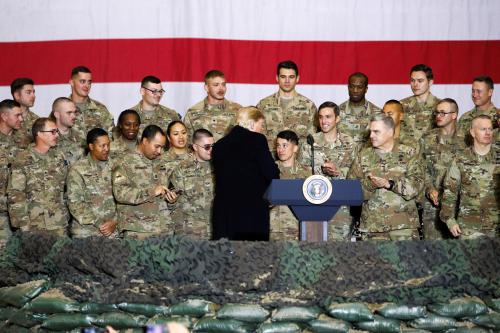
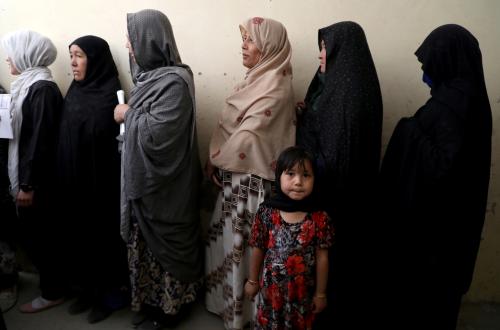

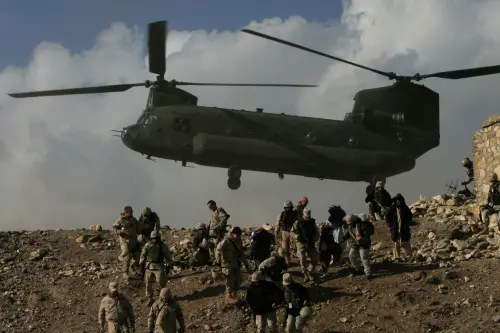
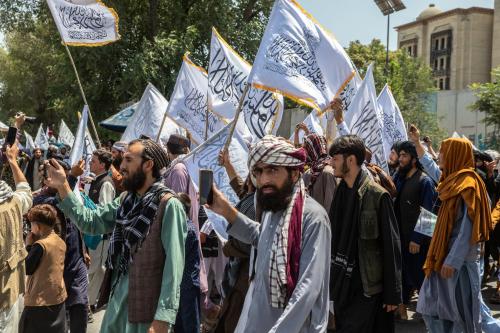
Commentary
America should stay in Afghanistan until an intra-Afghan deal is reached — not forever
October 13, 2020